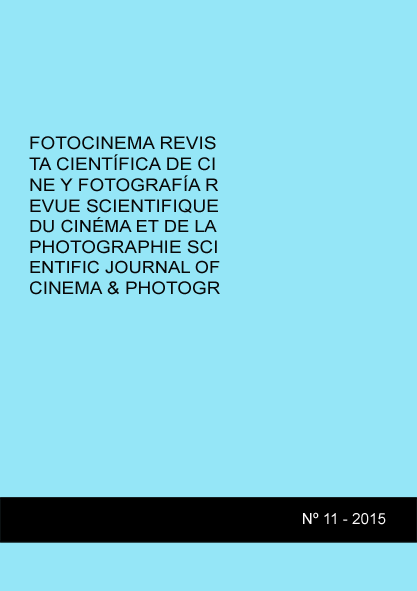Aportaciones historiográficas y estéticas a propósito de la co-autoría fílmica de The Last of the Mohicans (1920), de Maurice Tourneur y Clarence L. Brown
DOI:
https://doi.org/10.24310/Fotocinema.2015.v0i11.6075Abstract
El largometraje silente norteamericano The Last of the Mohicans (1920), sobre la famosa novela homónima de James Fenimore Cooper, se estrenó como co-dirigido por Maurice Tourneur y Clarence L. Brown. Tourneur era el productor y al inicio el único director, con Brown traba-jando como su ayudante. No obstante, poco después de iniciarse la filmación cayó gravemente enfermo, y Brown realizó la película casi al completo en su lugar. De ahí que Tourneur decidiera otorgar a su discí-pulo la mitad del crédito. Pese a ello, la polémica al respecto de su autoría ha rodeado siempre al film. Tal controversia surge a raíz de que The Last of the Mohicans está considerada por unanimidad como la obra maestra de Tourneur. Este artículo se centra en dicha problemática autoral, con objeto de establecer las verdaderas atribuciones de los dos directores. Para ello, previamente se ha analizado su relación profesional, que abarcó desde 1915 hasta 1921. Con posterioridad, a fin de establecer el grado de participación de cada uno de ellos, se han reconstruido los hechos relativos al rodaje a través de entrevistas de los que participaron en él (muchas de ellas hasta la fecha inéditas), así como de materiales publicados por la prensa de la época. Se ha llevado a cabo la consulta y confrontación de abundante material bibliográfico y, finalmente, el análisis plástico de las imágenes de la cinta.
Abstract:
The American silent film The Last of the Mohicans (1920), based on the famous homonymous novel by James Fenimore Cooper, was released as co-directed by Maurice Tourneur and Clarence L. Brown. Initially, Tourneur was the producer and the only director, with Brown being his assistant. However, shortly after shooting began he fell seriously ill. As a result, the film was almost entirely directed by Brown. Hence Tourneur decided to share the credit with his disciple. Still, the controversy concerning authorship has always surrounded the film. Such polemic arises from the fact that The Last of the Mohicans is considered unanimously Tourneur’s masterpiece. This article focuses on that authorial problematic, with the aim of determining the real responsibilities of both directors. In order to achieve this objective, their professional relationship (which spans from 1915 to 1921) has been previously analysed. Subsequently, to establish the degree of participation of each of them, the facts of the shooting have been reconstructed using interviews (many of them unpublished) from those who took part in it, as well as through contemporary trade papers. In addition, research and confrontation on extensive bibliography have been carried out. Finally, the visual analysis of the images of the film has been evaluated.
Palabras clave:
Maurice Tourneur; Clarence Brown; Hollywood; Associated Producers, Inc.; cine mudo.
Keywords:
Maurice Tourneur; Clarence Brown; Hollywood; Associated Producers, Inc.; Silent film.
Downloads
Metrics
Downloads
Published
How to Cite
Issue
Section
License
All contents published in Fotocinema Revista científica de cine y fotografía are protected under the Creative Commons Attribution-NonCommercial-ShareAlike 4.0 International (CC BY-NC-SA 4.0) license. All about this license is available in the following link: <http://creativecommons.org/licenses/by-nc-sa/4.0>
Users can copy, use, redistribute, share and exhibit publicly as long as:
- The original source and authorship of the material are cited (Journal, Publisher and URL of the work).
- It is not used for comercial purposes.
- The existence of the license and its especifications are mentioned.
There are two sets of authors’ rights: moral and property rights. Moral rights are perpetual prerogatives, unrenounceable, not-transferable, unalienable, imprescriptible and inembargable. According to authors’ rights legislation, Fotocinema. Revista científica de cine y fotografía recognizes and respects authors moral rights, as well as the ownership of property rights, which will be transferred to University of Malaga in open access. The property rights are referred to the benefits that are gained by the use or the dissemination of works. Fotocinema. Revista científica de cine y fotografía is published in an open access form and it is exclusively licenced by any means for doing or authorising distribution, dissemination, reproduction, , adaptation, translation or arrangement of works.
Authors are responsable for obtaining the necessary permission to use copyrighted images.













13.png)




